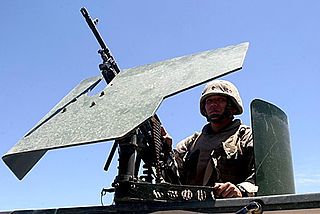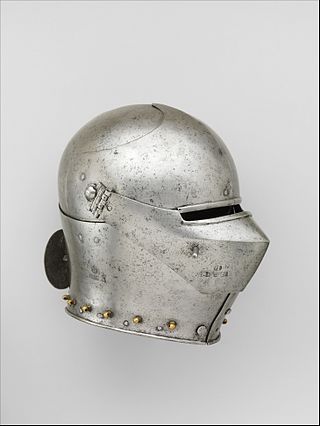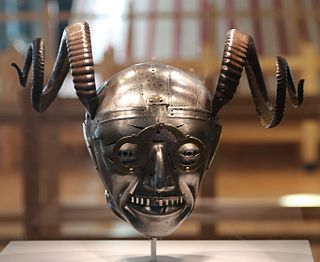Related Research Articles

A helmet is a form of protective gear worn to protect the head. More specifically, a helmet complements the skull in protecting the human brain. Ceremonial or symbolic helmets without protective function are sometimes worn. Soldiers wear combat helmets, often made from Kevlar or other lightweight synthetic fibers.

Jousting is a medieval and renaissance martial game or hastilude between two combatants either on horse or on foot. The joust became an iconic characteristic of the knight in Romantic medievalism.

A rondel dagger or roundel dagger is a type of stiff-bladed dagger used in Europe in the late Middle Ages, used by a variety of people from merchants to knights. It was worn at the waist and could be used as a utility tool, or worn into battle or in a jousting tournament as a side arm.
A visor was an armored covering for the face often used in conjunction with Late Medieval war helmets such as the bascinet or sallet. The visor usually consisted of a hinged piece of steel that contained openings for breathing and vision. Appropriately, breaths refers to the holes in the metal of the visor. Visors protected the face during battle and could be remarkably durable. One surviving artifact was found to be "equivalent in hardness to cold worked high speed steel."

Plate armour is a historical type of personal body armour made from bronze, iron, or steel plates, culminating in the iconic suit of armour entirely encasing the wearer. Full plate steel armour developed in Europe during the Late Middle Ages, especially in the context of the Hundred Years' War, from the coat of plates worn over mail suits during the 14th century.

The sallet was a combat helmet that replaced the bascinet in Italy, western and northern Europe and Hungary during the mid-15th century. In Italy, France and England the armet helmet was also popular, but in Germany the sallet became almost universal.

The bascinet – also bassinet, basinet, or bazineto – was a Medieval European open-faced combat helmet. It evolved from a type of iron or steel skullcap, but had a more pointed apex to the skull, and it extended downwards at the rear and sides to afford protection for the neck. A mail curtain was usually attached to the lower edge of the helmet to protect the throat, neck and shoulders. A visor was often employed from c. 1330 to protect the exposed face. Early in the fifteenth century, the camail began to be replaced by a plate metal gorget, giving rise to the so-called "great bascinet".

The Higgins Armory Museum is the name of a collection in the Worcester Art Museum. It was formerly a separate museum located in the nearby Higgins Armory Building in Worcester, Massachusetts, dedicated to the display of arms and armor. It was "the only museum in the country devoted solely to arms and armor" and had the second largest arms and armor collection in the country from its founding in 1931 until 2004, behind the Metropolitan Museum of Art in New York City. The collection consists of 2,000 objects, including 24 full suits of armor. The museum closed at the end of 2013 due to a lack of funding. Its collection and endowment were transferred and integrated into the Worcester Art Museum, with the collection on show in its own gallery. The former museum building was sold in December 2014 and now serves as a local events venue.

The great helm or heaume, also called pot helm, bucket helm and barrel helm, is a helmet of the High Middle Ages which arose in the late twelfth century in the context of the Crusades and remained in use until the fourteenth century. The barreled style was used by knights in most West European armies between about 1220 to 1350 AD and evolved into the frog-mouth helm to be primarily used during jousting contests.

A gun shield is a flat piece of armor designed to be mounted on a crew-served weapon such as a machine gun, automatic grenade launcher, or artillery piece.

The Royal Armouries Museum in Leeds, West Yorkshire, England, is a national museum that holds the National Collection of Arms and Armour. It is part of the Royal Armouries family of museums, with other sites at the Royal Armouries' traditional home in the Tower of London, and the National Collection of Artillery at Fort Nelson, Hampshire. The Royal Armouries is a non-departmental public body sponsored by the Department for Culture, Media and Sport.
Knights Must Fall is a 1949 Warner Bros. Merrie Melodies cartoon directed by Friz Freleng. The short was released on July 16, 1949, and stars Bugs Bunny. A spoof of the King Arthur mythology, the title is a pun on the 1937 film Night Must Fall.

The close helmet or close helm is a type of combat helmet that was worn by knights and other men-at-arms in the Late Medieval and Renaissance eras. It was also used by some heavily armoured, pistol-armed cuirassiers into the mid-17th century. It is a fully enclosing helmet with a pivoting visor and integral bevor.

Greenwich armour is the plate armour in a distinctively English style produced by the Royal Almain Armoury founded by Henry VIII in 1511 in Greenwich near London, which continued until the English Civil War. The armoury was formed by imported master armourers hired by Henry VIII, initially including some from Italy and Flanders, as well as the Germans who dominated during most of the 16th century. The most notable head armourer of the Greenwich workshop was Jacob Halder, who was master workman of the armoury from 1576 to 1607. This was the peak period of the armoury's production and it coincided with the elaborately gilded and sometimes coloured decorated styles of late Tudor England.

In heraldic achievements, the helmet or helm is situated above the shield and bears the torse and crest. The style of helmet displayed varies according to rank and social status, and these styles developed over time, in step with the development of actual military helmets. In some traditions, especially German and Nordic heraldry, two or three helmets may be used in a single achievement of arms, each representing a fief to which the bearer has a right. For this reason, the helmets and crests in German and Nordic arms are considered essential to the coat of arms and are never separated from it.

The frog-mouth helm was a type of great helm, appearing from around 1400 and lasting into the first quarter of the 16th century. The helmet was primarily used by mounted knights for tournaments (jousting) rather than on the battlefield.

Funerary Helmets,Mortuary Helms, or Mort Helms were the major element of a suit of armour that was most often placed above or near the carved memorial effigy of the knights or members of the nobility concerned in a tradition that ran from at least the 14th through to the 17th century, particularly when the person concerned had gained a reputation in life as a warrior. These helmets were often brightly painted or otherwise ornamented with floral designs, etc. Largely located within rural churches and other religious buildings, the practice was especially common in the south-west English counties and Cornwall with only a few examples known from Scotland.
Tobias Emanuel ("Toby") Capwell FSA is an American historian who lives and works in London. His principal interest is in European arms and armour of the medieval and Renaissance periods. He was formerly Curator of Arms and Armour at the Wallace Collection in London. He has written and spoken extensively on both the historical and the practical aspects of his subject. Capwell is also a skilled jouster, and has claimed to be the world's only jousting curator.

John Waller was an English pioneer of the historical European martial arts (HEMA) revival, a fight director for stage, screen and spectacle, and a teacher of martial arts.

The horned helmet of Henry VIII is the surviving part of a full suit of armour made by Konrad Seusenhofer between 1511 and 1514. The armour was a gift from the Holy Roman Emperor Maximilian I to the English king Henry VIII, following their alliance in the War of the League of Cambrai. The suit was elaborate and intended for display at tournament parades. It is unclear who was the intended wearer of the armour, but it appears to have been modelled on one of Henry's court fools. Henry may have worn the armour as a jest. The helmet has protruding eyes and a toothy grimace and is adorned with horns and spectacles. The helmet survived when the rest of the suit of armour was scrapped, probably after the English Civil War, and it is now in the collection of the Royal Armouries Museum in Leeds, which formerly used it as a symbol of the museum.
References
- ↑ Dufty, Arthur Richard (1968). European Armour in the Tower of London. H.M. Stationery Office, Ministry of Public Building and Works. p. 12.
... the headpieces were two of outstanding quality and importance: the Brocas helm and the close helmet now numbered IV. 412. The Brocas helm, an English jousting helm, named after an erstwhile owner, helped to fill a serious gap in the collection; to this day it and the Stowe helm are the only defences of their kind in the Armouries, other than the grotesque forgeries bought in the middle of the last century.
- ↑ The Penny Magazine of the Society for the Diffusion of Useful Knowledge. Vol. 9. London: Charles Knight. March 7, 1840. p. 96.
Only two of the visored bascinets of this period are known to exist, one in the Meyrick collection, the other in the Tower of London. The latter was added to the National Collection in the year 1834.
- ↑ Pyhrr, Stuart W.; Godoy, José (1998). Heroic Armor of the Italian Renaissance – Filippo Negroli and His Contemporaries. New York, N.Y.: Metropolitan Museum of Art. p. 184. ISBN 0-87099-872-2.
The earliest reference to this helmet occurs in the sale catalogue of the Brocas collection in 1834, in which the inscription on the brow plate is cited.4 The helmet was subsequently acquired by the eighth duke of Luynes, who formed in the second quarter of the nineteenth century a small but important collection of arms and armor at his château in Dampierre (Île de France).